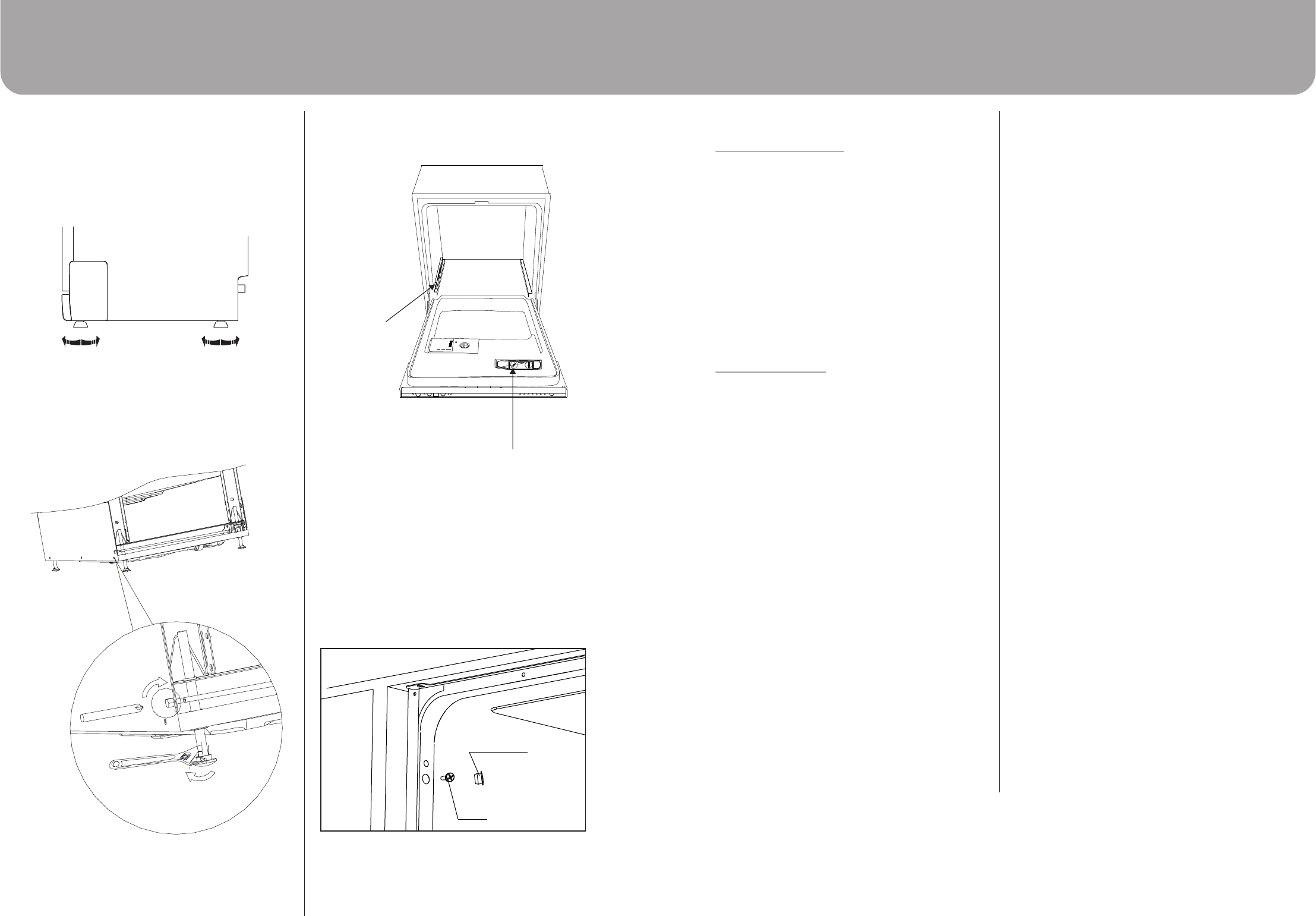
Installation Using Your Dishwasher
Levelling the Dishwasher
Once the appliance is positioned for levelling, the
Ÿ
height of the dishwasher may be altered via
adjustment of the screwing level of the feet. The
dishwasher must be level for proper dish rack
operation and wash performance. In any case, the
appliance should not be inclined more than 2 °.
The rear feet can be adjusted from the front of the
Ÿ
dishwasher by turning the screws on the left and
right hand side of the cabinet. To adjust the front
feet, use a wrench and turn the front feet until the
dishwasher is level.
Place level on door and rack track inside the tub as
Ÿ
shown to check that the dishwasher is level.
Check level side to side.
Check level
Front to Back.
Securing the Dishwasher
The dishwasher must be secured in place using either
of the following methods:
Normal work surface - secure to the work surface
Ÿ
by using two woodscrews ensuring the dishwasher
weight is not being hit by the surface.
Marble or granite work top - secure the bracket to
Ÿ
the side panel of the dishwasher and secure the
dishwasher to the furniture housing. Put the rubber
cap over the screw.
Suitability of items for use in your Dishwasher
Ÿ
Ÿ
Ÿ
Ÿ
Ÿ
Ÿ
Ÿ
Ÿ
Ÿ
NOT SUITABLE FOR USE
Cutlery with wooden, horn china or m o t h e r - o f -
pearl handles.
Plastic items that are not heat resistant.
Older cutlery with glued parts that are not
temperature resistant.
Bonded cutlery items or dishes.
Pewter or copper items.
Crystal glass.
Steel items subject to rusting.
Wooden platters.
Items made from synthetic fibres.
LIMITED SUITABILITY
Some types of glasses can become dull after a
Ÿ
large number of washes.
Silver and aluminum parts have a tendency to
Ÿ
discolour during washing.
Glazed patterns may fade if machine washed
Ÿ
frequently.
NOTE:
Do not put in items that are dirty with cigarette ash,
Ÿ
candle wax, lacquer or paint.
If you buy new dishes please make sure that they
Ÿ
are suitable for dishwashers.
Please do not overload your dishwasher. Do not
Ÿ
use dishes that are not suitable for dishwashers.
This is important for good results and for
reasonable energy consumption.
Before loading the dishes, you should:
Remove large food particles.
Ÿ
Soften remnants of burnt food in pans.
Ÿ
When loading the dishes and cutlery, please note:
Dishes and cutlery must not impede the rotation of
Ÿ
the spray arms.
Load hollow items such as cups, glasses, pans
Ÿ
etc. with the opening downwards so that water
cannot collect in the container or a deep base.
Dishes and items of cutlery must not lie inside one
Ÿ
another, or cover each other.
To avoid damage to glasses, they must not touch.
Ÿ
Load large items which are most difficult to clean
Ÿ
into the lower rack.
The upper rack is designed to hold more delicate
Ÿ
and lighter dishware such as glasses, coffee and
tea cups.
Long bladed knives stored in an upright position
are a potential hazard!
Long and/or sharp items of cutlery such as carving
knives must be positioned horizontally in the upper
basket.
Damage to glassware and other dishes
Possible Causes
Type of glass or manufacturing process. Chemical
Ÿ
composition of detergent.
Water temperature and duration of dishwasher
Ÿ
programme.
Suggested remedy:
Use glassware or porcelain dishes that have been
Ÿ
marked dishwasher-proof by the manufacturer
Use a mild detergent that is described as kind of
Ÿ
dishes If necessary, seek further information from
detergent manufacturers.
Select a program with as low a temperature.
Ÿ
To prevent damage, take glass and cutlery out of
Ÿ
the dishwasher as soon as possible after the
program has ended. as possible after the program
has ended.
ATTENTION!
Ÿ
Ÿ
Page 12 Page 21
